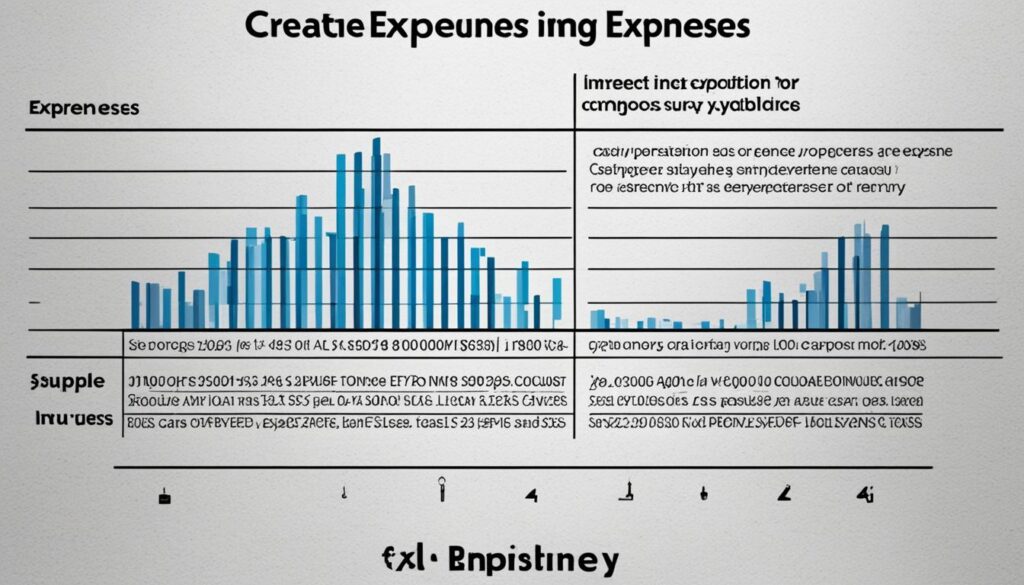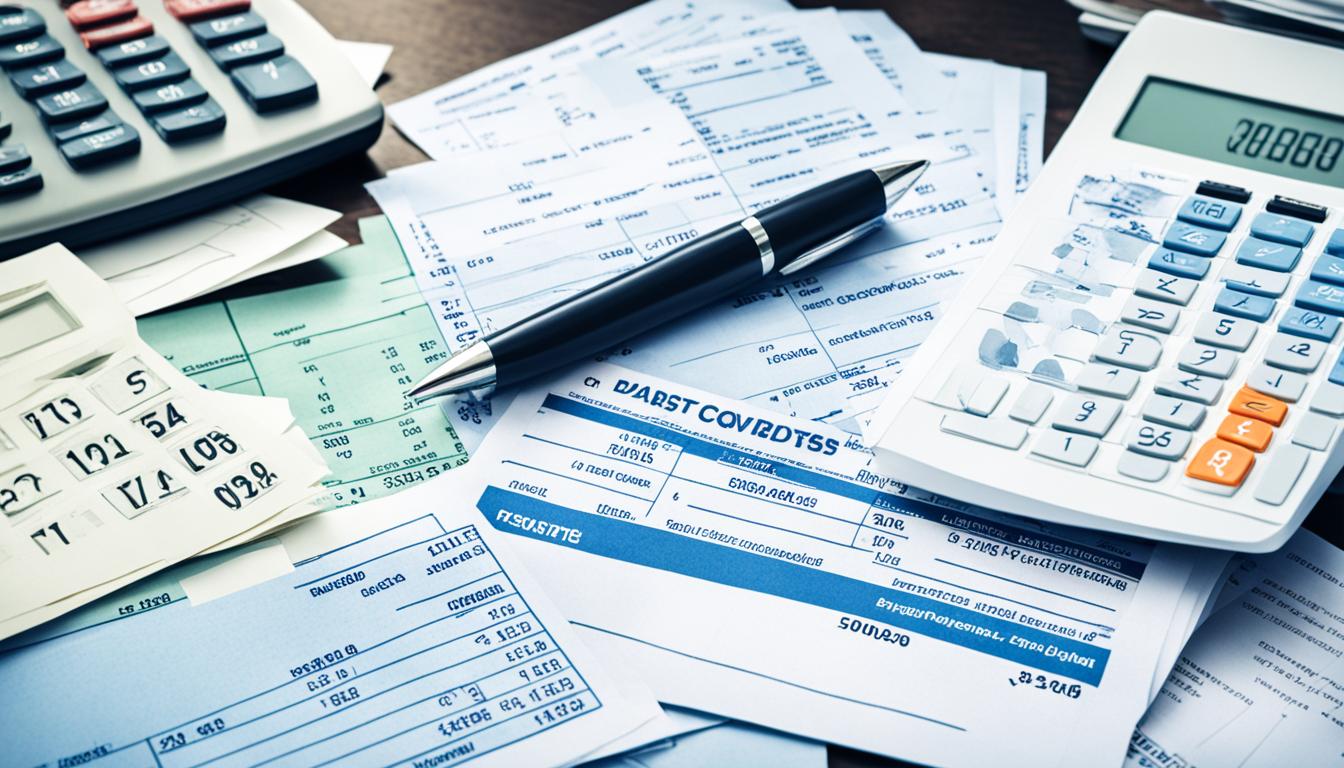Did you know that small business owners spend an average of 33% of their revenue on day-to-day operating expenses? That’s a significant portion of their income dedicated to keeping the business running smoothly.
Operating expenses, also known as OpEx, are the ongoing costs that businesses face to ensure their daily functioning. These expenses include rent, accounting fees, marketing charges, office supplies, payroll, utilities, and more. While these costs may not be directly tied to making or selling products, they are essential for the overall operation of the business.
In this article, we will delve into the details of operating expenses, understand how they impact a business’s financial health, and explore strategies for managing and optimizing these costs effectively.
Key Takeaways:
- Small business owners typically allocate around 33% of their revenue for day-to-day operating expenses.
- Operating expenses include various costs like rent, marketing charges, payroll, and utilities.
- Effective management of operating expenses is crucial for budgeting wisely and maximizing profitability.
- Understanding the difference between fixed and variable costs helps in calculating operating expenses accurately.
- Examples of operating expenses include personnel costs, occupancy expenses, administrative expenses, marketing and advertising costs, and research and development expenses.
What Are Operating Expenses?
Operating expenses are the repetitive costs that a business incurs to facilitate its day-to-day functioning. These expenses are vital for keeping the business running smoothly and ensuring its essential payments are made. Unlike costs that change with sales volume, operating expenses mostly stay the same regardless of revenue. They are distinct from costs directly tied to making or selling products, such as the cost of goods sold (COGS).
Common examples of operating expenses include:
- Rent
- Accounting fees
- Bank fees
- Marketing charges
- Office supplies
- Payroll
- Utilities
These costs are essential for the day-to-day functioning of the business and can vary depending on the industry and nature of the business. Understanding and managing these expenses is crucial for effective budgeting and efficient business functioning.
Managing operating expenses requires careful analysis and strategic decision-making. By optimizing and controlling these costs, businesses can improve their financial health and overall profitability.
Managing Operating Expenses
Managing operating expenses is a crucial responsibility for business management. While these expenses are inevitable, there are proven methods to reduce them and boost profits.
- Data-driven decision-making: By analyzing financial data and performance metrics, businesses can identify areas where operating expenses can be optimized. This includes evaluating the effectiveness of marketing campaigns, identifying cost-saving opportunities, and reallocating resources to high-impact areas.
- Flexibility in spending and budget adjustments: Regularly reviewing and adjusting budgets allows businesses to adapt to changing market conditions and optimize their spending. By closely monitoring expenses and making informed decisions, businesses can effectively manage cash flow and reduce unnecessary costs.
- Employee engagement: Encouraging employees to contribute cost-saving ideas can lead to significant savings. By establishing a culture of cost-consciousness and incentivizing employees to identify efficiencies, businesses can tap into their collective knowledge and expertise.
- Continuous improvement: Implementing processes and practices to continuously improve operational efficiency can result in long-term cost savings. This includes streamlining workflows, automating manual tasks, and optimizing resource allocation.
- Benchmarking: Comparing operating expenses with industry standards can provide insights into areas where businesses may be overspending. Benchmarking allows businesses to identify opportunities for cost reduction and efficiency improvements.
By effectively managing operating expenses, businesses can improve their financial health and competitiveness, ultimately boosting profits.
| Expense Category | Description |
|---|---|
| Personnel costs | Includes employee salaries, benefits, commissions, retirement plan contributions, payroll processing costs, and payroll taxes. |
| Occupancy expenses | Encompasses rent, utility bills, property taxes, and maintenance costs. |
| Administrative expenses | Covers tasks like domain registration, software subscriptions, communication expenses, and legal fees. |
| Marketing and advertising costs | Includes creating ads, running campaigns, and conducting market research. |
| Research and development expenses | Essential for businesses focusing on technological advancements and innovation. |
Fixed and Variable Costs
Operating expenses can be classified as fixed costs or variable costs. It is important for businesses to understand the difference between these two types of costs in order to effectively manage their operating expenses and calculate their financial obligations.
Fixed Costs
Fixed costs are recurring expenses that remain constant regardless of the quantity of goods or services sold. These costs are necessary for the day-to-day operations of a business and do not vary based on sales volume. Examples of fixed costs include:
- Rent
- Insurance
- Loan payments
Businesses must account for these fixed costs in their budgeting process, as they are unavoidable expenses that contribute to the overall operating expenses.
Variable Costs
Variable costs, on the other hand, fluctuate with production levels and sales. These costs are directly tied to the quantity of goods or services produced and sold by a business. Examples of variable costs include:
- Raw materials
- Direct labor costs
Unlike fixed costs, variable costs can change based on the level of production and sales, making them more flexible and responsive to business demands.
Calculating Operating Expenses
Calculating operating expenses involves summing up various cost components, including fixed costs and variable costs. It is important for businesses to accurately calculate their operating expenses in order to effectively manage their financial resources and make informed business decisions. Some of the key cost components to consider when calculating operating expenses include:
- Payroll/wages
- Sales commissions
- Marketing/advertising costs
- Rent
- Utilities
- Insurance
- Taxes
By understanding and accurately calculating their fixed and variable costs, businesses can gain insight into their operating expenses and make strategic decisions to optimize their financial performance.

Examples of Operating Expenses
Operating expenses can be further categorized into different types. It is important for businesses to understand these categories in order to effectively manage their day-to-day costs. Let’s take a closer look at some examples of common operating expenses:
Personnel Costs
Personnel costs encompass a wide range of expenses related to employees. This includes salaries, benefits, commissions, retirement plan contributions, payroll processing costs, and payroll taxes. Personnel costs are a key component of operating expenses and can significantly impact a business’s bottom line.
Occupancy Expenses
Occupancy expenses refer to the costs associated with a business’s physical space. This includes expenses such as rent, utility bills, property taxes, and maintenance costs. For businesses with a physical presence, managing occupancy expenses is essential for maintaining financial stability.
Administrative Expenses
Administrative expenses cover various behind-the-scenes tasks necessary for the smooth operation of a business. These can include expenses for domain registration, software subscriptions, communication, and legal fees. While these expenses may not be directly tied to revenue generation, they are essential for the day-to-day functioning of the business.
Marketing and Advertising Costs
Marketing and advertising costs are an important part of operating expenses, especially for businesses looking to promote their products or services. These costs can include creating ads, running campaigns, market research, and other promotional activities. Effective management of marketing and advertising expenses is crucial for optimizing return on investment.
Research and Development Expenses
Research and development (R&D) expenses are incurred by businesses focused on technological advancements and innovation. These expenses include investments in research activities, product development, and improving existing products or services. R&D expenses play a vital role in enabling businesses to stay competitive in an ever-evolving marketplace.
“Operating expenses can vary depending on the industry and nature of the business. Managing these expenses is crucial for budgeting wisely and maximizing profitability.”
Understanding and effectively managing operating expenses, including personnel costs, occupancy expenses, administrative expenses, marketing and advertising costs, and research and development expenses, is essential for businesses to thrive in today’s competitive landscape.

Conclusion
Understanding and effectively managing the day-to-day costs of running a business is crucial for budgeting wisely and maximizing profitability. Operating expenses, which include both fixed and variable costs, play a significant role in the financial health of a business. By carefully analyzing and optimizing expenses such as personnel costs, occupancy expenses, administrative expenses, marketing and advertising costs, and research and development expenses, businesses can improve their operational efficiency and enhance their competitiveness.
To achieve financial stability and long-term success, businesses should consider implementing strategies to reduce operating expenses. By making data-driven decisions and continuously monitoring expenses, businesses can identify areas for improvement and implement cost-saving measures. This approach will not only help businesses navigate day-to-day cost challenges but also provide opportunities for growth and expansion.
In conclusion, managing operating expenses is an ongoing process that requires diligence and strategic planning. By effectively managing day-to-day costs, businesses can achieve financial stability, seize new opportunities, and position themselves for long-term success in today’s competitive business landscape.
FAQ
What are day-to-day costs of running a business?
Day-to-day costs of running a business, also known as operating expenses, are the ongoing expenses that a business faces to keep things running smoothly. These include payments for rent, accounting fees, bank fees, marketing charges, office supplies, payroll, utilities, and more.
Why are operating expenses important?
Operating expenses are essential for the day-to-day functioning of a business and are not directly tied to making or selling products. Understanding and managing these expenses is crucial for budgeting wisely and efficiently.
How can I manage operating expenses?
Managing operating expenses is a crucial responsibility for business management. Some strategies include data-driven decision-making, flexibility in spending and budget adjustments, employee engagement to encourage cost-saving ideas, continuous improvement to work more efficiently, and benchmarking to compare expenses with industry standards.
What are fixed and variable costs?
Operating expenses can be classified as fixed or variable costs. Fixed costs are recurring expenses that remain constant regardless of the quantity of goods or services sold, such as rent, insurance, and loan payments. Variable costs fluctuate with production levels and sales, such as raw materials and direct labor costs.
What are examples of operating expenses?
Operating expenses can be categorized into various types. Personnel costs include employee salaries, benefits, commissions, retirement plan contributions, payroll processing costs, and payroll taxes. Occupancy expenses encompass rent, utility bills, property taxes, and maintenance costs. Administrative expenses cover tasks like domain registration, software subscriptions, communication expenses, and legal fees. Marketing and advertising costs involve creating ads, running campaigns, and market research. Research and development expenses are crucial for businesses focusing on technological advancements.
Why is understanding day-to-day costs important?
Understanding and effectively managing the day-to-day costs of running a business is essential for budgeting wisely and maximizing profitability. Operating expenses play a significant role in the financial health of a business. By analyzing and optimizing expenses, businesses can improve their operational efficiency and competitiveness.


